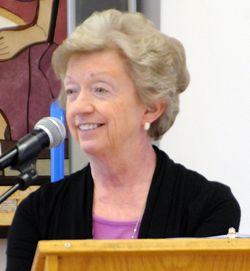Theologian addresses lay ecclesial ministry class
Friday, Nov. 11, 2016
SALT LAKE CITY — Four distinct Catholic spiritual traditions were the focus of an all-day workshop for members of the Diocese of Salt Lake City’s English-speaking Lay Ecclesial Ministry formation program Nov. 5.
The workshop presenter was Dr. Kathleen H. Brown, associate director of the Doctor of Ministry program at Virginia Theological Seminary and former director of Formation for Ministry at the Washington Theological Union.
Brown spoke on Benedictine, Ignatian and Salesian prayer and Carmelite spirituality, which have their own answers to the questions of who God is and who is the human person, she said. “Each of these traditions invites us into a deeper life of prayer, but they are all truly Christian Catholic in their belief that God is loving and inviting, that God desires to be in relationship with us, and that we as human persons are made in the image of God – that we are fundamentally good.”
Brown said she chose these particular spiritual traditions out of the many in the Catholic Church because she was asked to talk about prayer, and “each of these has a particular lens on what it means to pray.” She added that she hoped her listeners learned different ways that they can talk about prayer to people in their parishes, “but I also hope that it moves their own hearts, I hope that it does something for their own prayer life.”
This cadre of the LEM formation program is in the second year of a four-year process; those who complete it will be prepared to work in parish ministry or other areas of the Church. The LEMs not only need to be familiar with the various spiritual traditions, but they also must do the “hard work ... of examining where you are on your spiritual journey, and coming in contact with these different [spiritual] traditions gives you another way of thinking about it,” said Susan Northway, the director of the diocesan religious education office, who coordinates the LEM program.
In her presentation, Brown described prayer as “our relationship with God, and we need to take time for it, just as we need to take time for important human relationships.”
During the course of the day, Brown briefly described each of the four spiritual traditions and offered exercises in each to the workshop participants.
“What we learn from these contemplative traditions is that all of us have the capacity for contemplative prayer – it’s not just the spiritually elite,” she said.
The key ideas of Benedictine prayer are that prayer is about listening to God, who is always speaking to people; that everyone is called to be holy; and they are called to be holy in everyday life, she said. “In fact, [Benedict] believed that if we can’t be spiritual right where we are, then we can’t be spiritual at all.”
The Benedictine rule calls people to balance work, prayer, rest and play, she said, and “Benedictine prayer … has a lot to do with listening, listening for God in all of those parts of our lives, listening to Scripture and listening to the voices of others, especially the wise people in our lives.”
Saint Ignatius of Loyola, who founded the Society of Jesus, or Jesuits, developed his spirituality around the themes that God is in all things and that God speaks to people through their heart, mind and imagination. He also stressed a “holy indifference,” which is “a very active quality of the heart which says ‘I am going to put my desires in God’s hands,’” Brown said.
While the Benedictine and Ignatian traditions developed meditative prayer, “Carmelite spirituality is at the foundation of contemplative tradition,” which focuses on the spiritual journey of prayer, Brown said. She defined contemplation as a wordless state of stillness that allows the experience of union with God.
Two great contemplatives of the Carmelite tradition were Saint Teresa of Avila and Saint John of the Cross. Brown briefly discussed St. Teresa’s book Interior Castle, in which the saint writes about her experiences with God. Brown also touched on St. John’s poetry, which described his own spiritual experiences.
The key ideas of Carmelite spirituality are that God dwells at the core of very human soul; a “radical idea” that “is something that all of the contemplatives not only believed, but they felt it, they experienced it,” she said.
The idea of detachment – being willing to let go of worldly things to make room for God to work – is also important in the Carmelite tradition, Brown said. “God is calling us, sometimes forcing us, to let go of things that we cling to that are not God.”
This process is sometimes liberating, sometimes painful, but allows God to create something new, she explained.
Salesian spirituality arose from the teachings of Saint Francis de Sales and Saint Jane Frances de Chantal, who founded the Congregation of the Visitation.
Because St. Francis de Sales was a spiritual director to many lay women as well as religious women, “it gives his spirituality a quality that makes it very accessible to all of us,” Brown said.
The key themes of this spirituality are a universal call to holiness, humility, gentleness, friendship, she said, and “the purpose of prayer in the Salesian tradition is expanding the heart, expanding our capacity to love.”
There are three degrees of prayer in this tradition: meditation, contemplation and “recollection,” which is the experience of being called by name by God, Brown said.
For questions, comments or to report inaccuracies on the website, please CLICK HERE.
© Copyright 2024 The Diocese of Salt Lake City. All rights reserved.
© Copyright 2024 The Diocese of Salt Lake City. All rights reserved.


Stay Connected With Us